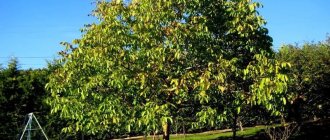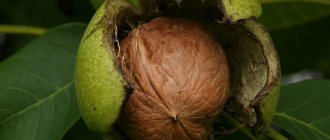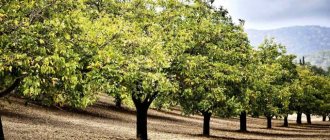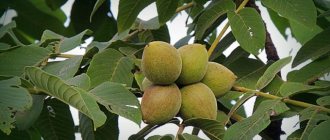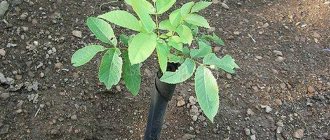Where does black walnut grow and what does it look like?
The natural habitat of black walnut is forests, river banks and the foothills of the mountains of North America. Today it is cultivated in other countries. In Russia, he feels great in the Krasnodar region and Stavropol region.
This is a powerful spreading tree with large carved leaves. Life expectancy is 70-80 years. The nut is named black not for its dark fruits, but for its strong black tap root system. The nut kernels, peel and leaves are used for medicinal purposes.
The tree blooms in May and produces fragrant yellow-green catkins. The fruits ripen in September. They are larger than walnuts and have a dense skin, first green, then brown. The bark of the tree is dark with rough veins. The wood is hard, but easy to work with. Walnut is used in furniture production for its beautiful wood grain.
Description and origin
The culture's homeland is North America, which is why it is often called the American walnut. It came to Russia only in the 18th century and grows successfully in the Stavropol and Krasnodar regions. The plant can grow in Canada and other countries, but only under certain conditions.
Black walnut is similar in appearance to walnut, but has a higher content of nutrients. It is for this reason that it is more useful and as it matures, the value of such a product increases.
The plant's trunk appears chocolate brown and grows up to 30 meters. The black walnut tree is a monoecious crop whose staminate flowers are collected in small catkins. It blooms in spring, starting from 7-10 years.
The bark of the plant looks strong, but is quite easy to process. The bark is a valuable material and is used to make various household items. Furniture is made from the bark and used for interior decoration.
The fruits of the plant look like round, egg-shaped nuts that are pointed at the top. They grow and ripen in a 5-10 mm thick peel, inside of which there is a fairly strong shell. It contains edible kernels that emit a specific smell.
Composition and calorie content of black walnut
Like all nuts, black nuts contain a lot of fat. Approximately 90% are lipid compounds. Therefore, the calorie content of the kernels is about 600-620 kcal per 100 g. The kernels have a pleasant sweetish taste, so they are used in their pure form, fried, and added to salads and desserts.
The kernels contain a huge number of valuable components. These are minerals, vitamins, antioxidants, bioflavonoids, tannins, organic acids. But the substance juglone is of particular value. It is present in both the fruits and leaves of black, walnuts and other nuts.
Important! Juglone has a powerful antibacterial and antimicrobial effect, expels parasites, cleanses the blood and lymph, and helps with endocrine diseases. This substance gives the nut a characteristic iodine aroma and colors the hands.
The following were found in the peel and kernels of the plant:
- ascorbic acid;
- vitamins P, PP, E, groups B, A, F;
- manganese, iron, phosphorus, selenium, magnesium, potassium, etc.;
- organic iodine;
- essential oils;
- carotene;
- Sahara;
- enzymes;
- linolenic, oleic, lauric, stearic and other acids;
- glycosides;
- alkaloids, etc.
In general, the fruit of the American tree is a concentrated cocktail of a lot of useful components. That is why it is widely used in folk and official medicine.
Benefits and harms of fruits
The fruits are edible and have a characteristic original taste. The kernels contain 55-66% fat. The nutritional value of the kernels corresponds to that of an English walnut.
Beneficial features
The fruits are used as a food additive. They contain vitamins of groups A, B, C, E, PP, as well as fatty acids. 10 nut kernels contain a concentrated dose of iodine that a person needs every day. The fruits also contain tannin and carotene.
Useful properties of kernels:
- blood pressure normalizes, blood vessels dilate;
- treatment of infections is accelerated;
- brain activity is stimulated;
- immunity is strengthened;
- acne disappears;
- used in the fight against worms;
- Skin tone increases, wrinkles smooth out.
The kernels are eaten fresh or lightly fried. An adult needs to eat 8-10 pieces, and children no more than 5. The kernels are added to first and second courses as a seasoning and used in making desserts.
Harm
Despite the many beneficial properties, there are certain limitations and contraindications. Due to their high fat content, nuts are a high calorie product. Overweight people should not eat them.
Fried kernels are not recommended for patients with gastritis. Allergy sufferers should also be careful. Nuts are a strong allergen. Large consumption of kernels can cause allergic reactions. The use of kernels is contraindicated for pregnant and nursing mothers and children under 5 years of age.
Black walnut is an interesting plant with which you can simultaneously decorate your garden and get delicious fruits. To grow a crop, you need to choose the right site and provide proper care.
What are the benefits of black walnut?
The main thing that black walnut is valued for is its high biological activity against fungi, bacteria and parasites. No less important is its ability to suppress the development of tumors, both benign and malignant.
Here is a list of the beneficial properties of black walnut:
- cleanses lymph and blood;
- resolves cysts and tumors;
- stimulates the immune system;
- has an antioxidant effect;
- effective against parasites;
- disinfects;
- calms;
- rejuvenates;
- relieves pain;
- dilates blood vessels;
- fights nausea and vomiting.
In addition, the nut is a source of vitamins, minerals and acids, important for the normal functioning of all human systems and organs. It is used for intestinal infections, mycoses, for the treatment and prevention of oncology, and to increase the body's defenses.
Meaning and Application
Black walnuts are grown not only for harvesting fruits and decorating plots, but also for timber.
Main characteristics:
- the core can have a different shade: from light brown to rich chocolate, darker stripes are observed;
- wood color of different shades (red, purple, greenish);
- there are patterns on the fibers;
- medium natural shine;
- straight, sometimes uneven, fibers.
Black walnut products are easy to work with. The material adheres well, is processed, and is perfectly polished.
Characteristics and mechanical properties of black walnut
| Characteristic name | Meaning |
| Genus | Juglans |
| View | nigra |
| Density | 610 kg/m3 |
| Janka hardness | 4.49 kN |
| Static bending strength | 100.7 MPa |
| Modulus of elasticity at static bending | 11.59 GPa |
| Compressive strength along the fibers | 52.3 MPa |
| Radial shrinkage | 5,5 % |
| Tangential shrinkage | 7,8 % |
| Volumetric shrinkage | 12,8 % |
It is valued in furniture making because it has a unique color – dark gold. Products made from this material have a beautiful appearance, resistance to external influences, and antiseptic properties.
Wood contains special glycosides, essential oils and organic acids. Therefore, furniture made from it is protected from the growth of bacteria and fungal spores.
But the material has a significant disadvantage - low strength. When sawing, wood bends. If complex decorative pieces of furniture are assembled, then the disadvantage becomes an advantage. In such cases, the elasticity of the wood is required.
In order for the furniture to last for a long time, it is necessary to properly dry and store the boards. Wood is used to make:
- floor coverings;
- butts for weapons;
- decorative items;
- musical instruments.
The value of wood is great not only for industrial production. The products of this tree have found their use in medicine and pharmacology. The extract is used in the preparation of tinctures and medicines.
Is black walnut good for pregnancy and breastfeeding?
The rich composition and antimicrobial properties will be useful to every pregnant woman, whose body experiences a double load and is very sensitive to any viruses and infections. If a woman has previously consumed black walnut and did not develop any side effects, it can be consumed during pregnancy, but in small quantities. A few purified nucleoli are enough to maintain the health of the body.
If a woman has not consumed black walnut before pregnancy, you should not experiment due to the risk of developing an allergic reaction. During breastfeeding, the product is on the unwanted list. It is high in calories and allergenic, so it may be too dangerous for a newborn.
What is the difference between black and walnuts?
Both walnuts and black walnuts belong to the walnut family, which explains the lack of many characteristic features. The crown, trunk, leaves and even the fruits of these two plants are very similar, which makes them easy to confuse. However there are a few differences:
- Composition . Walnut and black walnut fruits contain aromatic compounds, polyphenols and juglones. However, if you pay attention to their quantity, you will see that black walnut has an order of magnitude more of these substances.
- Aroma . The aroma that comes from the black walnut fruit is more intense than the aroma of the walnut fruit. This can easily be explained by the fact that black walnut contains more volatile aromas.
- Treatment effectiveness . Tinctures prepared with black walnut are more effective than those containing walnut fruits.
Based on the above facts, we can conclude that the benefits of consuming black nuts are much greater than the benefits of consuming walnuts. In this case, the substances included in its composition can have a unique effect on the human body, accelerating regeneration and preventing the development of cancer and many other diseases.
At what age can black walnut be given to a child?
Walnut kernels contain many useful biologically active components in high concentrations. Small children may not tolerate this product well, so it is advisable to give it no earlier than 3-4 years after birth. For the first time, you can give the child only one nucleolus, and take a break for several days to monitor the reaction. If all is well, children are given several kernels a day to remove parasites, strengthen the immune system, improve sleep, and replenish the lack of minerals and vitamins.
Restrictions for use and side effects
There are a number of contraindications for treatment with black walnut. Their list includes:
- pregnancy, breastfeeding;
- allergies;
- exacerbation of gastritis and peptic ulcer;
- thrombophlebitis, blood thickening;
- cirrhosis of the liver;
- alcoholism;
- childhood;
- individual intolerance.
It is forbidden to consume more than one handful of nuts per day. To avoid harm to health, they must be fresh. This product has a high calorie content, which should be kept in mind by people who are overweight.
Beneficial properties of black walnut leaves
The leaves of this plant contain no less valuable components than the fruits, but their concentration is slightly lower. For medicinal purposes, decoctions and tinctures from the leaves are used for:
- destruction of helminths;
- increasing immunity;
- combating fungal infestations;
- relieving inflammatory processes.
Black walnut leaves have astringent properties and antioxidant effects. Remedies made from the leaves are good for eczema, acne and other skin problems. They are taken to improve intestinal microflora, treat sinusitis, sinusitis and bronchitis, and are useful for ARVI, influenza and intercostal neuralgia.
How to grow black walnut: planting methods and choosing a location for the tree
On a private plot, this unusual nut appears in the form of a seedling or ripe fruit. Most gardeners prefer not to bother with seedlings, but to purchase young trees from a nursery. If you think the same, give preference to seedlings under 3 years old. Older nuts are more difficult to adapt to and tolerate transplantation less well.
In nurseries you can find seedlings called “black American walnut”. Don’t hesitate and buy – it’s the same culture. The American walnut is called for its historical homeland.
If the required variety of seedling is not available for sale and if you wish, you can grow it yourself. All you need to do is buy a dozen ripe nuts and show a little patience.
Subtleties of growing nut seedlings from fruits
First of all, keep in mind that black walnut fruits have a thick and durable skin. If you plant them dry, you will have a long wait for sprouts. A simple soaking procedure will help speed up germination. Place the fruits in a jar of water and let them sit for 3 days. Don't forget to change the water every day. On the fourth day, plant the nuts in pots, one in each. A higher percentage of germination is observed if you use wet sand rather than soil.
Do not make the hole too deep - 10 cm is enough. Place the nut itself on its side.
By the way, it is best to germinate nuts in the fall, immediately after harvesting, while the fruits are fresh. True, the seedlings will move into open ground only next spring, after overwintering in the basement. If there is no such wintering room, wait until April.
To preserve the fruits and not disappear, sprinkle them with sand and leave them in the pantry until spring. In this case, start germinating black walnuts in late March - early April. The seedlings can be transplanted into the garden as soon as the frosts pass and stable warmth is established. But it is advisable that the young nut spend its first year of life not outside. If you do not cover it well, the seedling will die.
Where and how to plant black walnut
Frankly speaking, black walnut is not a tree for small areas. Its far-reaching roots and deciduous crown overflowing with phytoncides will leave no chance for its nearby neighbors. The minimum distance between two nuts must be at least 15 m, so it is unlikely that it will be possible to plant a grove. Walnut foliage purifies the air well and has antibacterial properties, but it is dangerous for most garden and vegetable crops. The fragrant leaves release a toxin called juglone, which will quickly kill nightshade crops and potatoes. Do not plant pear, plum and apple trees near black walnut - it will oppress them.
When choosing a place in the garden for a seedling, focus on the requirements of black walnut, namely:
- It needs neutral, not acidic soil, otherwise the tree will not have time to retire and prepare for the winter.
- Black walnut can grow on heavy soils, but prefers loam with moderate humidity. Enrich too poor soil by adding phosphorus-potassium preparations, humus and ash when planting in the hole.
- To keep the crown lush and the tree strong and healthy, find a light area for the nut.
Plant the tree so that the darker part of the trunk faces south.
Recently, mycorrhization—the colonization of fungal mycelium into the root system—has become increasingly popular among walnut growers. For all nut crops, the symbiont fungus is the black truffle. Thus, walnut mycorrhiza allows for faster rooting of both seedlings and cuttings. Trees that develop together with mycorrhiza winter better, do not get sick and produce higher yields.
This technology can also be used when growing black walnut. The drug Mikovital contains beneficial spores. Soak the roots of the seedling in it before planting or add it to the water when watering. And your black walnut will quickly begin to grow.
Black walnut tincture: uses and contraindications
This medicine is prepared from unripe fruits with green skin, pouring alcohol into them. The product is very strong, so treatment begins with a few drops a day.
Taken for the following health problems:
- endocrine disorders;
- helminthic infestations;
- oncological tumors;
- chronic diseases of the ENT organs;
- weakened immunity.
The benefits and harms of black walnut tincture have a complex effect on the body, which can be both positive and negative in different cases. For each disease, a clear regimen for using the tincture is followed.
How to take for oncology
The use of the tincture involves long-term use for 12 months. Every 3 weeks they take a break for 7 days and resume taking it again. To achieve the effect, try 0.5 tsp on the first day of use. tincture diluted in water. On the second day, the dose is doubled. By the 4-5th day the daily dose is 2 tsp. 4 times a day before meals. The tincture is diluted in water and drunk in small sips.
From parasites
Expulsion of helminths is also a long process. On average, treatment is carried out for six months with weekly breaks, as in the previous scheme. The tincture is diluted in water, 2 tsp. to be taken twice a day. If a person’s body weight is more than 80 and 90 kg, the dose is increased accordingly to 2.5 and 3 tsp. in one go. Children are not given alcohol tincture. It is beneficial for them to eat nut kernels, but after consulting a doctor.
Medicinal properties
The ability of the Canadian walnut to resist cancer is widely known in the world. This effect is provided by unripe fruits and foliage, in which the concentration of juglone and polyphenolic components is high. The non-toxic effect helps cancer patients during chemotherapy.
Black walnut is used in the treatment of:
- gastrointestinal pathologies;
- immunodeficiency;
- tuberculosis;
- skin lesions of various nature;
- genitourinary system;
- allergic problems;
- parasite infestations;
- varicose veins and thrombophlebitis;
- atherosclerosis;
- diarrhea in acute or chronic stages;
- diabetes mellitus
The main effect in treatment is associated with blood purification, removal of toxic components and parasites, solving skin problems, and restoring the immune system.
On a note. Black and walnut are similar in their chemical composition. The peel and kernels of the walnut contain similar components, but in black walnut their concentration is much higher, which creates a stronger effect in treating diseases.
Benefits of black walnut extract
It is prepared from the green peel of an unripe fruit. In folk medicine, the extract is used to treat purulent wounds, treat boils, eczema, and diathesis. It is useful for gynecological and venereal diseases. For problems in the functioning of the endocrine system with the development of diabetes mellitus, the extract is also indicated for use.
Important! The aqueous extract helps with intestinal problems and in the treatment of diseases of the bronchopulmonary system in children over 3 years of age.
Suppositories with nut extract are used in gynecology to treat thrush. Rectal suppositories are useful for anal fissures. In folk medicine, an extract diluted with water is recommended for general cleansing of the body.
Black Walnut (Juglans nigra L.)
Black walnut is one of the tallest trees in the walnut family. The homeland of black walnut is North America, where its many-sided medicinal and preventive properties have long been actively used. In Russia, black walnut is found in botanical gardens and in a wild form in the Stavropol and Krasnodar territories. Local residents know this plant and never confuse it with the walnut, its close relative. *** Black walnut extract is included in the following preparations:
“Nuxen” is a homeopathic tincture made from black walnut leaves. Indicated for the treatment of colds, diseases of the oral cavity, upper respiratory tract, to restore the activity of the gastrointestinal tract, and for diabetes.
"Yuglon" is a dietary supplement consisting of liquid black walnut extract with ascorbic acid. It is used for prostatitis, eczema, thyroid dysfunction, neurodermatitis, inflammation of the female genital area, ovarian cysts, urethritis, chronic pyelonephritis, pulmonary tuberculosis, and is also an anthelmintic and choleretic agent.
Oil is obtained from black walnut fruits by extraction. Black walnut oil is used in medicine, cosmetology and cooking. Deodorized black walnut oil can be found in pharmacies. It is used to prevent colds, stomach and duodenal ulcers, intestinal dyspepsia, intestinal dysbiosis, chronic gastritis and colitis, and immune system disorders. Black walnut oil is also effective for skin diseases and eczema, diabetes and thyroid dysfunction. The oil is used in the treatment of vitamin deficiency and rickets, diseases of the female genital organs and reproductive system, acute conjunctivitis, hemorrhoids, thrombophlebitis. Inhalations and mouth rinses are made with black walnut oil.
Botanical description
Black walnut is a large North American tree; in natural conditions it reaches 45 m in height and 1.5-1.8 m in diameter. Black walnut bark is dark brown, cracking early; buds are bare, shoots are slightly pubescent. Leaves are up to 40-50 cm long, consist of 15-23 oblong-lanceolate leaflets, acute at the apex, finely toothed along the edge, dark green above, glabrous, weakly pubescent below, up to 12 cm long and up to 4 cm wide. Upper leaf less lateral and often falls off. Men's earrings are 6-15 cm long, women's earrings are in tassels of 3-5 pieces. It blooms and bears fruit from 10-15 years. Black walnut flower formula: ♂ (↑O4-TAx); ♀ ((X)O2+2P(2-)). The nut kernel is enclosed in a thick, rough peel (endocarp), small in size, difficult to extract, and therefore almost never used. Recently, breeders have isolated forms with a thin skin and a large kernel (seed) from black walnut. The fruits are spherical, up to 6 cm in diameter. The pericarp is indehiscent and turns black when ripe. The nuts are spherical to obovate, about 4 cm in diameter, dark brown or black, with two jagged-wavy ribs and longitudinal grooves between them, opening with difficulty.
Spreading
Black walnut is native to North America, where it grows in broadleaf forests and occupies a wide range from Massachusetts south to Florida, and west to Minnesota and Texas. In the south of Russia there are plantings of this plant that are sufficient for industrial harvesting. The nut grows well and bears fruit in the Stavropol and Krasnodar regions, and in the city of Sochi there are mature plants that produce a bountiful harvest of nuts. Also found in botanical gardens.
Procurement of raw materials
For medicinal purposes, fresh leaves, unripe fruits, peel, and black walnut bark are used. Black walnut fruits are harvested in the fall. There is a variety of equipment for collecting and processing nuts, but it is also possible to do this work by hand. Ripe nuts fall on their own; you just need to collect them from the ground. You can use a machine or a long stick to get the nuts out of the tree. Knocking nuts with a stick can damage branches and leaves. After collection, the process of processing the nuts begins. When processing manually, it is necessary to use rubber gloves, since the juice of the black walnut fruit is difficult to wash off. The husk of black walnut varies in color from dark green to yellowish green. The black walnut husk can be removed using a knife. You can also remove the skin with your hands after crushing the nut. Opened nuts can be placed in water and the peel will float. Brown nuts need to be thoroughly dried, then the kernels are removed using a hammer, vice or tongs. Nuts with shells are stored better. It is enough to place them in cotton bags or metal containers and put them in a cool, dark place. In this way, nuts are stored for more than 6 months.
Chemical composition
Black walnut fruits are saturated with the following substances: flavonoids, alkaloid jugladine, polyphenolic substance "juglone", tannins, carotene, phytoncides, glycosides, organic iodine, quinone, enzymes, sugar and tannins. The fruits also contain many vitamins (C, B1, B6, P, E, B, PP, provitamin A and vitamin F), essential oils, various beneficial acids (oleic, linolenic, palmitic, linoleic, lauric, myristic, arachidic and stearic ).
Pharmacological properties
The healing properties of black walnut are due to the healing substances included in its composition. Due to the high concentration of juglone and polyphenol, black walnut is actively used against parasites, has a laxative and antifungal effect. Tannins make black walnut indispensable in the treatment of skin diseases, as they actively promote the healing of damage and prevent further infection. This is what black walnut juice is famous for. Tinctures and infusions of black walnut strengthen the walls of blood vessels, have an antisclerotic effect, normalize blood pressure and prevent bleeding.
Use in folk medicine
Black walnut is used in folk medicine. Preparations based on black walnut are actively used as antiparasitic agents. It is also believed that treatment with black walnut is effective for the prevention of influenza, in the treatment of gastric and duodenal ulcers, chronic gastritis, dyspepsia, intestinal dysbiosis, and chronic colitis. Black walnut is used for dysfunction of the thyroid gland, inflammatory diseases of the female genital area, hormonal disorders, in urology and proctology. Black walnut oil has been used since ancient times for skin diseases, as well as for rickets in children. Tinctures and ointments from ebony bark are used to treat tumors, ulcers and sexually transmitted diseases.
Historical reference
The Indians of North America considered black walnut the elixir of life and used it to treat various diseases, including using it to save themselves from snake bites. Black walnut is unique in its healing, restorative and rejuvenating effects on the human body; there are no analogues among plants. Since ancient times, black walnut has been used to treat tuberculosis, fight parasites, skin diseases, stomach diseases, and also to treat inflammation.
Benefits and uses of black walnut oil
It is produced on an industrial scale for the cosmetic and pharmaceutical industries. Taken both internally and used externally. In cosmetology, deodorized oil is used for:
- acne;
- inflammatory diseases of the skin of the face and body;
- diathesis;
- psoriasis;
- dermatitis.
Effective oil for dry and dehydrated skin and dry hair. It is used both in its original form and added to medicinal home masks.
The drug is used internally to treat stomach ulcers in remission. It is indicated for intestinal and sexually transmitted infections, during a flu epidemic, for hemorrhoids, colitis, bladder diseases and vitamin deficiency.
The oil can be taken separately or added to food, such as salads and cereals. They lubricate cracks in the skin, rashes, flaky areas, and give a head massage.
Black walnut wood. Wood species
Wood species admin 2019-02-19T00:14:32+00:00
This species is famous for its dense wood, which has dark reddish and brown shades, and also boasts beautiful texture and size. It is because of this that elm (elm, elm) has gained incredible popularity among furniture manufacturers and designers.
Sycamore maple (Figured Sycamore) is common in Central Europe and Western Asia. It is also commonly called figured, flamed or false sycamore. The solid of this rock has a white or yellowish-white color with a characteristic natural shine and a pattern in the form of mother-of-pearl waves, clearly visible in a radial section. The fibers can be arranged straight, curled or wavy. The texture of the wood is fine-grained, hard, its dry density is about 630 kg/m3, and the main mechanical properties are similar to oak wood. Solid Sycamore maple is used in the production of exclusive furniture, flooring, veneer and a variety of turning products.
American walnut—that which grows in North America—has a slightly darker wood, to a chocolate color. To enhance color saturation, it is usually steamed. The wood is predominantly straight-grained. A little softer than European. American black walnut (Juglans nigra) looks especially advantageous under varnish - this is how the rich range of shades of its heartwood is revealed. Wood of similar quality comes from Myanmar - it is called Burmese walnut. Black walnut wood is considered one of the most valuable among deciduous species, has a chocolate-brownish color with a density of 0.60-0.61 g/cm3, hard, durable, easy to process and polish well, and is one of the most valuable mahogany woods (mahogany, rosewood).
Walnut wood is considered a valuable species and is used for the manufacture of high-quality interior items and furniture. It is a by-product of growing walnuts, and therefore its supply to loggers is not constant. Enterprises using this wood in production are few in number and focused on small volumes.
Mountain poplar grows exclusively on the slopes of the Caucasus Mountains. Its wood has a brownish core, yellow sapwood and brownish veins. It itself is homogeneous, straight-grained, odorless, which cannot but please those who are skeptical about specific odors. As for the physical and mechanical properties of mountain poplar wood, its density is lower than that of oak, ash or larch.
Mulberry, or mulberry, is a tree species with yellowish-white sapwood, sharply separated from the reddish-brown core. When exposed to light, the wood darkens and becomes dark brown. Mulberry wood is highly valued. In Central Asia, it is used to make musical instruments. It is used as a construction and ornamental material in carpentry and cooperage due to its exceptional qualities - dense, elastic, heavy.
Elastic and durable ash wood has been valued at all times. Ash wood resembles oak, it is somewhat lighter, and has no core rays. When stained and dyed, it acquires an unpleasant gray color, so it is usually used in its natural color. Steamed ash bends well. The wood is quite viscous and difficult to process manually. When dried, ash cracks little. In the past, bows, arrows, war clubs and spears were made from ash wood, hoops, wheels, and rocker arms were bent. Beautiful dishes were made from ash wood (especially a lot of it was found during excavations of Veliky Novgorod). Nowadays it is used for the production of model aircraft and various machine parts (in mechanical engineering). Thanks to its beautiful texture, ash wood is valued on a par with mahogany in furniture production.
Oak wood is distinguished by its strength, strength, density, hardness and heaviness. The properties of wood depend on the growing conditions of the tree. Its wood is dense, hard, heavy and highly durable. It is also characterized by resistance to moisture, rot and various fungi due to the presence of tannins in the wood. The wood is porous with a beautiful texture. The color is brown or yellowish brown. The sapwood part of oak wood has a light yellow color. Over time, the color of its wood darkens, which gives it a more noble appearance.
Spalt is a colony of fungus or bacteria that forms colored spots or veins that are uncharacteristic of the breed. Often different types of fungus are planted on beech or maple and subsequently stabilized. After defeat, the wood acquires a unique pattern. Special wood-staining mushrooms stain rotten wood. The color and texture of such wood can be very different: from white to dark brown with greenish, blue, yellow hues and a complex pattern of thin brown and black threads. This makes “rotten” wood attractive for wood carving, carpentry and turning.
Preparation and use of black walnut decoction
A decoction is prepared from fresh or dried nut leaves. For 1 glass of boiling water take 1 tbsp. l. crushed raw materials, pour in and leave for 1 hour. The broth is used to wash hair, rinse the mouth, and make compresses for eczema and diathesis.
The decoction is taken internally for the following diseases:
- atherosclerosis;
- gout;
- internal bleeding;
- diabetes;
- diarrhea.
The daily volume of this decoction is 1 glass. You can divide the dose into 2 doses. The course of treatment is 2-3 weeks.
How to plant black walnut.
The place for black walnut should be sunny and protected from north and northeast winds. The tree's root system will be powerful, corresponding to a wide crown.
Humus, ash and fertilizer are poured into the planting hole and the seedling is installed. When the roots of the seedling are almost completely covered with soil, water is poured into the hole. After all the water has gone into the ground, the hole is completely filled with earth, and the tree trunk circle is covered with mulch. You need to carefully examine the trunk of the seedling before planting. The part of the trunk that was burned out by the sun was facing south. This orientation must be maintained during landing.
Black walnut capsules and tablets
This is a dietary supplement made from leaves. Available as capsules for oral administration. Each manufacturer offers its own dosage regimen depending on the existing diseases and the weight of the active components. Instructions for use of the extract usually indicate a daily dosage of 1-2 capsules. The course of treatment is 3 weeks.
Indications for use:
- fungal, bacterial infections;
- parasites;
- weakened immune system;
- avitaminosis;
- problems in the intestines.
Capsules are indicated for cleansing blood and lymph of toxins and improving hematopoietic function.
Growing black walnut for timber. Profit and prospects
The first results will be obtained in a few years at test sites. It is necessary to study the dynamics of growth over a long period and adjust agricultural technology.
Growing black walnut has promise and requires testing. A timber project is a long-term investment.
The cost of 1 m3 of unedged walnut wood board in the world is about 5 thousand US dollars, plus or minus depending on the type and climate of the place of growth. A cube of walnut wood is obtained from three ten-year-old walnut trees. When planting 625 trees per hectare, the profit from the sale of wood will be $1.1 million. $100 thousand per year per hectare.
The main suppliers of walnut wood are traditionally considered to be China, the USA, France, Ukraine and Moldova. If we talk about Europe, the nut is grown most often in Ukraine, and in France there are more industrial orchards. Moldova also exports both timber and walnuts.
Walnut wood is a valuable species and is mainly used to make high-quality products. In our country, walnuts are mainly grown for harvesting the fruit, and its wood is often used as a by-product of production. That is why its supply to factories is irregular and usually enterprises that are focused on small production volumes work with it. If we talk, for example, about France, then walnuts are grown there specifically for timber production and this country is the leader in the presence of industrial walnut orchards. Very often the nut tree is dug up along with the roots. This is explained by the fact that the parts of the trunk located in the ground are usually tuberously thickened. They are used to make veneer from twisted wood, which is very valuable.
The properties of walnut wood allow it to be used for the manufacture of such critical parts as weapon butts, car parts, and it is also widely used for the manufacture of parquet, furniture, and home interior design. Such properties of walnut wood as a slight tendency to crack and high dynamic strength led to the fact that in wartime the number of these trees was greatly reduced, as they were used for the manufacture of butts of small arms.
Black walnut in cooking
Black walnuts are used in cooking, like other nuts. It is eaten whole grains, fried and added to salads. Good baked goods with crushed kernels. Washed, dried fruits are used to make a powder that is added to cereals and confectionery products.
Jam made from young green fruits has unique properties. The process of preparing it is long, but the taste of this dessert is unusual, especially if spices are added during the cooking process - cinnamon, cardamom and others.
We recommend reading: The benefits and harms of cardamom
Medicinal properties and contraindications of American nut
Generally
American walnut has such beneficial properties:
- Antimicrobial.
- Antioxidant.
- Anti-inflammatory.
- Antiviral.
- Antiparasitic.
- Astringents.
- Calming.
The B vitamins contained in the composition, amino acids and magnesium have a sedative effect.
But in addition to its beneficial properties, black walnut also has contraindications. It should not be used :
- Children under 2 years old.
- Nursing mothers.
- Pregnant.
- For allergy sufferers.
- Overweight people.
Attention!
Excessive consumption of the fruits of this tree can also cause harm to the body. You can eat a maximum of 10 pieces at one time.
Excess can lead to:
- dizziness;
- nausea;
- vomiting;
- spasm of cerebral vessels.
For men
This product helps men:
- Increase potency and physical activity.
- Reduce the effect of stress on the central nervous system.
- Bring your stomach back to normal.
- Boost your immune system.
- Prevent the development of diseases of the cardiovascular system.
For women
For women, black walnut helps improve the general condition of the body and prevent the following diseases:
- Depression.
- Inflammation in the organs of the reproductive system.
- Thyroid diseases.
In addition, this product contains substances that help improve the appearance of skin, nails and hair.
For children
Black walnuts should be introduced into the diet of children carefully . But when used correctly, this product will bring the following benefits:
- Will increase physical and brain activity.
- Improves immunity.
- Will prevent vitamin deficiency.
Harm of black walnut and contraindications
Consumption of this product should be in moderation. It is permissible to eat an incomplete handful of peeled fruits per day. Black walnut is included in the list of highly allergenic foods and is therefore harmful to people with intolerance to certain foods. Individual intolerance to the components is a direct contraindication to its use.
The product may cause harm if you have the following diseases:
- stomach ulcer, gastritis;
- thrombophlebitis;
- liver diseases;
- irritable bowel syndrome.
People who are on a diet and want to lose weight should not include it in their diet due to the high calorie content of the nut.
Method of collecting, processing and storing nuts
Fruit picking usually begins in the fall, and this can be done either manually or using special machines.
Very ripe nuts fall to the ground on their own, so you can simply collect them with your hands while wearing gloves. After collecting ripe nuts, they begin to process them and this is usually carried out using technology. When handling with your hands, it is recommended to wear gloves, since the juice of the black walnut fruit leaves stains on the skin that are quite difficult to remove.
The skin of green nuts changes its color to yellowish-green. You can remove the peel and remove the fruit using a regular knife. In addition, you can first crush the fruit and then remove the skin with your hands.
